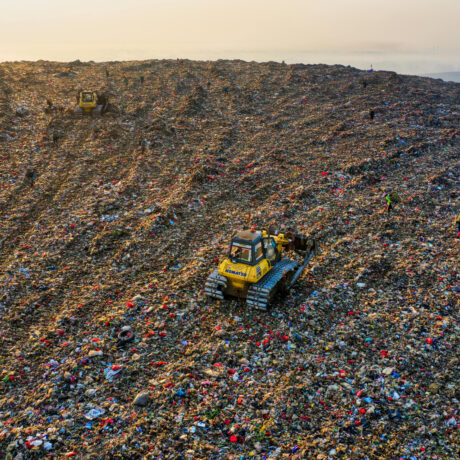Greenhushing in the fashion industry: the new negative sustainability trend?
Greenhushing a divatiparban: az új negatív fenntarthatósági trend?
A fenntartható divat és a környezettudatos vásárlás egyre népszerűbb témákká váltak az elmúlt években, a hétköznapi fogyasztók is jobban figyelemmel kísérik és érzékenyebben reagálnak divatmárkák lépéseire, döntéseire. Könnyen lehet, hogy már te is hallottál a greenwashing jelenségről, de mi a helyzet a csendesebb „testvérével”, a greenhushinggal, az úgynevezett zöld elhallgatással? Utánajártunk, hogy mit jelent pontosan ez a fogalom és hogyan érinti a divatipart, a gyártókat és a fogyasztókat.

Mi az a greenhushing?
A greenhushing olyan gyakorlat, amikor cégek, márkák szándékosan elhallgatják fenntarthatósági erőfeszítéseiket és céljaikat, még akkor is, ha azok jó szándékúak és előrevezetőek. Ennek egyik fő oka a “greenwashing” vádjától vagy a nyílvános kritikáktól való félelem. Ezen túlmenően sokan tartanak attól is, hogy ha nyilvánosságra hozzák fenntarthatósági céljaikat, és azokat nem sikerül teljesíteniük, akkor hitelességük csorbulhat. Ez a jelenség különösen a kisebb vállalkozások körében figyelhető meg, amelyek számára a fenntarthatósági tanúsítványok megszerzése költséges lehet, ezért inkább a háttérben végzik fenntartható tevékenységeiket.
A greenhushing jelenség azonban több szempontból is problémás. Egyrészt gátolja az iparág átláthatóságát, hiszen a márkák nem osztják meg egymással és a nyilvánossággal a fenntarthatósági gyakorlatokat és innovációkat, amelyek másokat is inspirálhatnának, edukálhatnának, változásra sarkallhatnának. Másrészt a fogyasztók egyre inkább igénylik a vállalatok fenntarthatósági tevékenységeiről szóló információkat, és a kommunikáció hiánya pedig bizalmatlanságot szülhet. Ezen kívül, ha nem vállalják fel nyilvánosan a fenntarthatósági céljaikat, akkor elmarad a számonkérhetőség is, ami szintén nem előrevezető a környezeti változások elősegítésében.
A greenhushing tehát, bár elsőre ártalmatlannak tűnhet, hosszú távon akadályozza a fenntarthatóságra irányuló globális erőfeszítéseket, és éppen ezért akár ugyanolyan káros lehet, mint a greenwashing.
Mi a különbség?
A legfőbb különbség a greenwashing és a greenhushing között az, hogy mit osztanak meg (vagy mit nem) a fogyasztókkal, és ezt milyen szándékkal teszik.
A greenwashing során a vállalatok túlzó állításokkal és megtévesztő marketinggel próbálják fenntarthatónak feltüntetni magukat, míg a greenhushing esetében szinte éppen az ellenkezője történik: elhallgatják vagy minimalizálják környezettudatos tevékenységeiket és a környezetvédelmi gyakorlataikat. Az eredmény mindkét esetben az, hogy a fogyasztók nem kapnak teljes képet, így átláthatatlanná válnak a márkák valódi tevékenységei és nem tudhatjuk meg, hogy mi zajlik pontosan a háttérben.

Miért választják a márkák a greenhushingot?
Bár a greenhushing kedvezőtlen hatással van a divatiparra, nem szabad hibáztatni az etikus kisvállalkozásokat, ha óvatosan bánnak fenntarthatósági céljaik nyilvánosságra hozatalával. Gondoljunk csak bele, hogy milyen kihívásokkal találkozik egy kis, etikus márka.
Nem könnyű fenntarthatóan működni kis márkaként, akiknek nem csak az elindulás nehéz, hanem az is, hogy tartósan a piacon tudjanak maradni, így az etikus divatmárkák különösen nehéz helyzetben találhatják magukat. Elég csak abba belegondolni, hogy a fenntartható ruházat előállítása és etikus marketingje sokkal magasabb árakat követel, -miközben a haszonkulcs alacsonyabb-, mint a fast fashion óriások esetében. A fenntartható alapanyag, a lokális gyártás, a kézművesség mind-mind hozzájárul ahhoz, hogy a végén miért lesz a termék ára sokkal magasabb, mint a tömeggyártott daraboknak. A slow fashion minőséget és értéket képvisel.
A kisvállalkozásoknak legtöbbször nincs elég erőforrásuk, hogy profi kommunikációs csapatokat vagy jogi szakértelmet alkalmazzanak, így inkább nem osztanak meg információkat, hogy elkerüljék a greenwashing vádját.
Továbbá, ebben a túlzottan érzékeny világban, sok kisebb, de akár nagyobb cég is fél attól, hogy ha túl sokat oszt meg fenntarthatósági terveiről és nem tudják maradéktalanul teljesíteni azokat, akkor kritikát kapnak. Ez kis márkaként akár vevő és publikumvesztést is jelenthet, amit nem engedhet meg magának sem a kezdeti, sem a későbbi időszakokban. Így az ilyen helyzetekben legtöbben inkább a csendet választják.

Te vagy én tudunk tenni valamit a greenhushing csökkentésében? Igen!
- Támogassuk az átláthatóságot: Keressünk olyan márkákat, amelyek őszintén beszélnek termékeikről és gyártási folyamataikról.
- Legyünk megértőek: A kisvállalkozások gyakran szűkös erőforrásokkal dolgoznak, de sokuk valóban igyekszik fenntarthatóbbá tenni az ipart.
- Tudatos vásárlás: Keressük az etikus és fenntartható márkákat, valamint tájékozódjunk vásárlás előtt.
Bár a greenhushing nem olyan feltűnő, mint a greenwashing, mégis komoly kihívást jelent a divatipar átláthatósága szempontjából. Az ipar fenntartható átalakulásához nemcsak a márkák aktív részvételére van szükség, hanem a fogyasztók tudatosságára is, hiszen csak így érhető el, hogy a divat valóban fenntarthatóbb és átláthatóbb legyen. De vajon ugyanolyan veszélyes a greenhushing, mint a greenwashing? Jó kérdés, és talán nincs is rá egyértelmű válasz.
Az viszont biztos, hogy azok a cégek és márkák, amelyek a zöld elhallgatást választják, egyúttal azt is eldöntik, hogy nem osztják meg jó példáikat, innovatív és eredeti gondolataikat – pedig ezek másokat is inspirálhatnának a fenntarthatóbb működésre. Így jogosan tehetjük fel a kérdést magunkban, hogyha pozitív példák rejtve maradnak, hogyan várhatjuk el, hogy a fenntartható fejlődés valóban széles körben elterjedjen és vajon hogyan alakulhat át a divatipar egy olyan ágazattá, amely nemcsak a környezettudatosságot hirdeti, hanem annak hiteles képviselőjévé is válik? Talán ez lehet az elkövetkezendő időkben a divatipar egyik meghatározó kérdése, amelyre a választ a gyártónak és fogyasztónak együtt kell keresnie.
Írta/ fordította: Kovács Enikő
Források:
Greenhushing in Fashion: It’s Bad… But We Kind of Get it | Sustainable Fashion Blog | Project Cece
MN6 Energiaügynökség – Greenhushing – az új negatív fenntarthatósági trend
A greenhushing ma már legalább akkora gond, mint a greenwashing – Portfolio.hu
Mi az a greenhushing és miért olyan népszerű a cégek körében?
Képek forrása: Unplash.
English
Greenhushing in the fashion industry: the new negative sustainability trend?
Written/translated by: Enikő Kovács
Sustainable fashion and eco-conscious shopping have become increasingly popular topics in recent years, with everyday consumers paying closer attention and reacting more sensitively to the actions and decisions of fashion brands. You may have heard of the phenomenon of greenwashing, but what about its quieter “brother”, greenhushing? We looked into what exactly this concept means and how it affects the fashion industry, manufacturers and consumers.
What is greenhushing?
Greenhushing is the practice of companies and brands deliberately hiding their sustainability efforts and goals, even if they are well-intentioned and progressive. One of the main reasons for this is the fear of being accused of “greenwashing” or being publicly criticized. In addition, many people fear that if they make their sustainability goals public and fail to meet them, their credibility may be damaged. This phenomenon is especially observed among smaller businesses, for which obtaining sustainability certificates can be expensive, and therefore they prefer to carry out their sustainable activities in the background.
However, the greenhushing phenomenon is problematic in several ways. On the one hand, it hinders transparency in the industry, as brands do not share with each other and with the public the sustainability practices and innovations that could inspire, educate and stimulate change. On the other hand, consumers are increasingly demanding information about companies’ sustainability activities, and a lack of communication can lead to distrust. In addition, if they do not publicly commit to their sustainability goals, there is a lack of accountability, which is also not conducive to promoting environmental change.
So, while greenhushing may seem harmless at first glance, it hinders global efforts towards sustainability in the long run and can therefore be just as harmful as greenwashing.
What is the difference?
The main difference between greenwashing and greenhushing is what is shared (or not shared) with consumers, and with what intention.
In greenwashing, companies try to portray themselves as sustainable through exaggerated claims and misleading marketing, while in greenhushing, almost the opposite happens: they conceal or minimize their environmentally conscious activities and practices. The result in both cases is that consumers do not get the full picture, making the real activities of brands opaque and preventing us from knowing exactly what is going on behind the scenes.
Why do brands choose greenhushing?
While greenhushing has a negative impact on the fashion industry, we can’t blame ethical small businesses for being cautious about publicizing their sustainability goals. Just think about the challenges a small, ethical brand faces.
It’s not easy to operate sustainably as a small brand, which not only has a hard time getting started, but also has a hard time staying in the market, so ethical fashion brands can find themselves in a particularly difficult position. Just think about the fact that the production and ethical marketing of sustainable clothing requires much higher prices – while the profit margin is lower – than in the case of fast fashion giants. Sustainable raw materials, local production, craftsmanship all contribute to why the price of the product is much higher in the end than mass-produced pieces. Slow fashion represents quality and value.
Small businesses often lack the resources to hire professional communications teams or legal expertise, so they prefer not to share information to avoid accusations of greenwashing.
Furthermore, in this hyper-sensitive world, many smaller and even larger companies are afraid that if they share too much about their sustainability plans and fail to fully implement them, they will be criticized. As a small brand, this can even mean losing customers and audiences, which you cannot afford either in the initial or later periods. So in such situations, most people prefer to remain silent.
Can you or I do something to reduce greenhushing? Yes!
Support transparency: Look for brands that are honest about their products and production processes.
Be understanding: Small businesses often work with limited resources, but many of them are genuinely trying to make the industry more sustainable.
Shop consciously: Look for ethical and sustainable brands and do your research before you buy.
Although greenhushing is not as visible as greenwashing, it still poses a serious challenge to transparency in the fashion industry. A sustainable transformation of the industry requires not only the active participation of brands, but also consumer awareness, as this is the only way to truly make fashion more sustainable and transparent. But is greenhushing as dangerous as greenwashing? It’s a good question, and perhaps there’s no clear answer.
What is certain, however, is that companies and brands that choose to remain green are also choosing not to share their good examples, innovative and original ideas – which could inspire others to operate more sustainably. Thus, we can rightly ask ourselves the question: if positive examples remain hidden, how can we expect sustainable development to truly spread widely and how can the fashion industry transform into a sector that not only promotes environmental awareness, but also becomes a credible representative of it? Perhaps this could be one of the defining questions of the fashion industry in the coming times, the answer to which must be sought by the manufacturer and the consumer together.
Sources:
Greenhushing in Fashion: It’s Bad… But We Kind of Get it | Sustainable Fashion Blog | Project Cece
MN6 Energiaügynökség – Greenhushing – az új negatív fenntarthatósági trend
A greenhushing ma már legalább akkora gond, mint a greenwashing – Portfolio.hu
Mi az a greenhushing és miért olyan népszerű a cégek körében?








